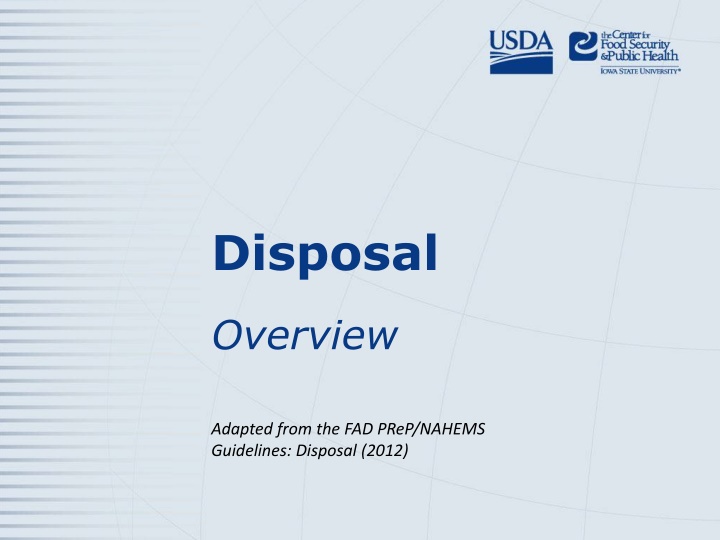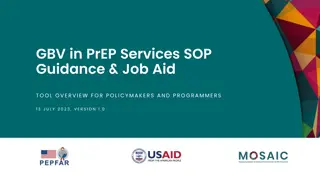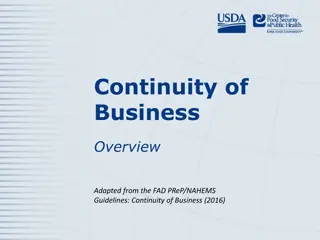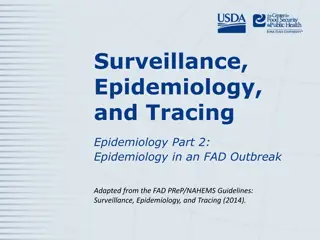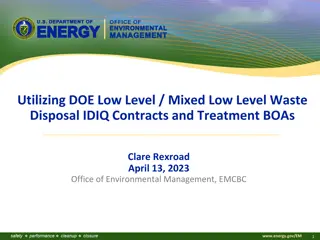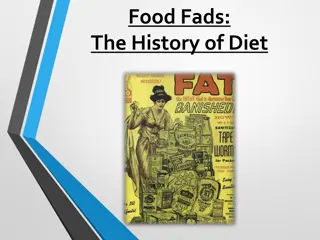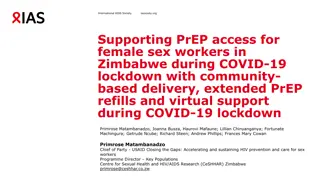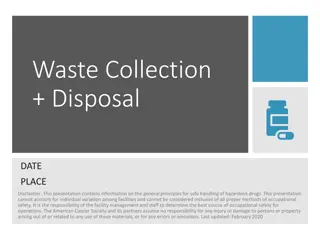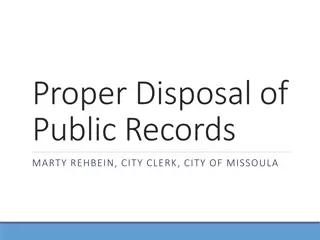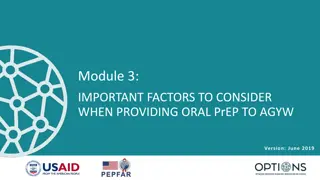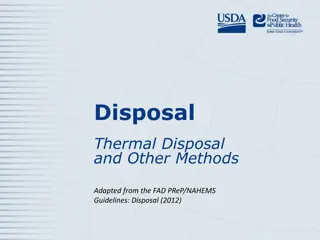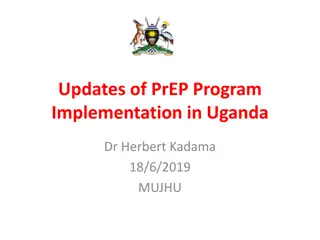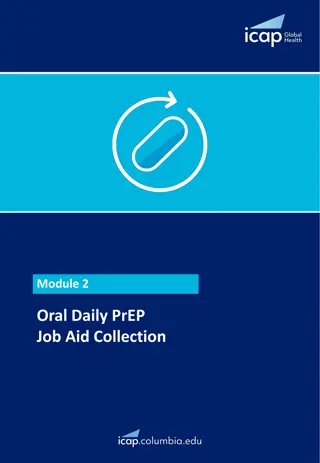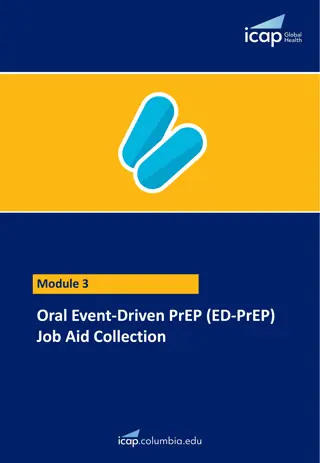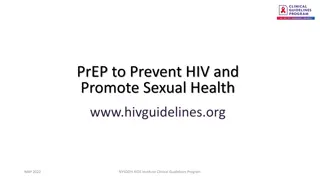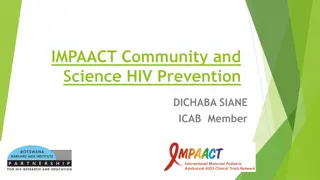Disposal Overview and Roles in FAD PReP Guidelines
This presentation provides an overview of disposal methods and the roles and responsibilities outlined in the FAD PReP/NAHEMS Guidelines. It covers the selection considerations, classification of waste materials, and the Incident Command System used for managing disposal situations. The roles discussed include those of the Disposal Group Supervisor, Team Leader, and Team Members. Preparation aspects involving cooperation, communication, and specific disposal methods like composting and rendering are also detailed.
Download Presentation

Please find below an Image/Link to download the presentation.
The content on the website is provided AS IS for your information and personal use only. It may not be sold, licensed, or shared on other websites without obtaining consent from the author.If you encounter any issues during the download, it is possible that the publisher has removed the file from their server.
You are allowed to download the files provided on this website for personal or commercial use, subject to the condition that they are used lawfully. All files are the property of their respective owners.
The content on the website is provided AS IS for your information and personal use only. It may not be sold, licensed, or shared on other websites without obtaining consent from the author.
E N D
Presentation Transcript
Disposal Overview Adapted from the FAD PReP/NAHEMS Guidelines: Disposal (2012)
This Presentation Responder roles and responsibilities Overview of disposal methods Selection considerations Classification of waste materials FAD PReP/NAHEMS Guidelines: Disposal - Overview USDA APHIS and CFSPH
Roles and Responsibilities FAD PReP/NAHEMS Guidelines: Disposal - Overview USDA APHIS and CFSPH
Incident Command System Used to manage people and resources Disposal Group personnel Operations Section Vary depending on incident size and scope FAD PReP/NAHEMS Guidelines: Disposal - Overview USDA APHIS and CFSPH
Disposal Group Personnel Disposal Group Supervisor Makes disposal method recommendations Organizes and directs disposal activities Disposal Group Team Leader Ensures disposal procedures are carried out Team Members Perform disposal activities FAD PReP/NAHEMS Guidelines: Disposal - Overview USDA APHIS and CFSPH
Preparation Cooperation and communication State Veterinarian State Agency for Environmental Protection Appraisal Group and Compensation Unit Euthanasia Group Biosecurity Group Cleaning and Disinfection Group FAD PReP/NAHEMS Guidelines: Disposal - Overview USDA APHIS and CFSPH
Specific Disposal Methods FAD PReP/NAHEMS Guidelines: Disposal - Overview USDA APHIS and CFSPH
Composting Overview Decomposition method Carcasses placed between layers of carbon rich organic materials Aerobic process Nitrogen provided by carcasses Carbon provided by plant materials (co-compost/ cover materials) FAD PReP/NAHEMS Guidelines: Disposal - Overview USDA APHIS and CFSPH
Rendering Overview Uses heat to convert carcasses into Protein-based solids Water Melted fat/tallow Inedible products Dry rendering Batch or continuous throughput FAD PReP/NAHEMS Guidelines: Disposal - Overview USDA APHIS and CFSPH
Permitted Landfill Overview Three types of permitted landfills Construction and demolition Hazardous waste Municipal solid waste Used for catastrophic carcass disposal FAD PReP/NAHEMS Guidelines: Disposal - Overview USDA APHIS and CFSPH
Unlined Burial Overview Carcasses or waste materials placed in trench, earthen hole, or pit Buried materials degrade over time Leachate produced Groundwater contamination possible Heavy equipment needed FAD PReP/NAHEMS Guidelines: Disposal - Overview USDA APHIS and CFSPH
Thermal Methods Overview High-temperature combustion Three methods Fixed facility incineration Highly controlled and effective Open-air (uncontrolled) burning Poorly controlled, negative air quality effects Air-curtain incineration Forced air and fuel improve efficiency FAD PReP/NAHEMS Guidelines: Disposal - Overview USDA APHIS and CFSPH
Novel Disposal Methods Disposal options in development Lactic acid fermentation Gasification In situ plasma vitrification Alkaline hydrolysis Drawbacks Expensive Used in highly specialized operations Sized for routine use FAD PReP/NAHEMS Guidelines: Disposal - Overview USDA APHIS and CFSPH
Site-Specific Disposal Method Selection Criteria FAD PReP/NAHEMS Guidelines: Disposal - Overview USDA APHIS and CFSPH
Disposal Method Selection Regional limitations Safety considerations Animals to be disposed Biomass (including by-products) Equipment Species Personnel Temporary storage FAD PReP/NAHEMS Guidelines: Disposal - Overview USDA APHIS and CFSPH
Avoiding Negative Impacts Environmental Air and water quality Soil integrity Biosecurity Transportation (human/vehicular traffic) Wildlife and scavengers Impact human and/or animal health FAD PReP/NAHEMS Guidelines: Disposal - Overview USDA APHIS and CFSPH
Waste Classification and Disposal FAD PReP/NAHEMS Guidelines: Disposal - Overview USDA APHIS and CFSPH
Classification Overview All non-nuclear waste designated as solid Hazardous (solid) waste Medical/infectious (solid) waste Utilize professionals to help classify waste FAD PReP/NAHEMS Guidelines: Disposal - Overview USDA APHIS and CFSPH
Associated Waste Materials Waste materials can include: Liquid wastes (milk, wastewater, etc.) Manure, litter, slurry Livestock feeds Disposal methods vary according to pathogen May include burning, burial, composting, or landfilling FAD PReP/NAHEMS Guidelines: Disposal - Overview USDA APHIS and CFSPH
For More Information FAD PReP/NAHEMS Guidelines & SOP: Disposal (2012) http://www.aphis.usda.gov/animal_ health/emergency_management/ Disposal web-based training module http://naherc.sws.iastate.edu/ FAD PReP/NAHEMS Guidelines: Disposal - Overview USDA APHIS and CFSPH
Guidelines Content Authors Rene Dewell, DVM, MS (CFSPH) Tom Glanville, PhD (Iowa State University) Significant contributions to the content were provided by USDA APHIS VS: Lori P. Miller, PE Darrel K. Styles, DVM, PhD FAD PReP/NAHEMS Guidelines: Disposal - Overview USDA APHIS and CFSPH
Acknowledgments Development of this presentation was by the Center for Food Security and Public Health at Iowa State University through funding from the USDA APHIS Veterinary Services PPT Author: Kerry Leedom Larson, DVM, MPH, PhD, DACVPM Reviewers: Janice Mogan, DVM; Rene Dewell, DVM, MS
